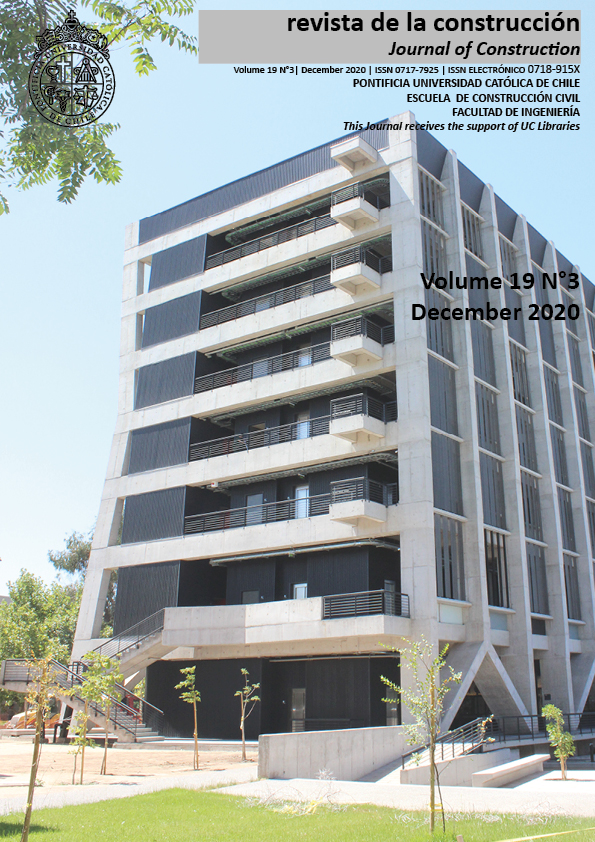Evaluating the asphalt pavement's surface characteristics by field testing
DOI:
https://doi.org/10.7764/rdlc.19.3.474-485Keywords:
Skid resistance, Friction resistance, Pavement surface texture, Mean texture depth, Mean profile depthAbstract
Pavement management systems are crucial because of monitoring the current pavement condition to supply safe, efficient, comfortable and durable riding surface for vehicles. Driving safety is the most important issue, which is closely related to pavement surface texture. The texture of the pavement surface and its ability to resist the polishing effect of heavy traffic is an important parameter in providing necessary skidding resistance during the service life. In this study, 4 different asphalt pavement sections located in Izmir/TURKEY with having different traffic characteristics were investigated every three months for two years aiming to evaluate the effect of traffic volume on the surface textural and frictional properties of the pavement. The textural properties were evaluated using sand patch test (SPT) and a 3D Laser Scanning System (LSS), while Dynamic Friction Tester (DFT) was employed to assess the frictional properties. As a result, lower Mean Texture Depth (MTD) and Mean Profile Depth (MPD) values were obtained for the increased traffic volumes. High correlation was derived between macro and micro textural properties of the asphalt pavement. Additionally, the textural and frictional properties were found highly related for the investigated asphalt pavement surfaces.
Downloads
References
[2] Li, L., & Wang, K. C. (2016). Geometric texture indicators for safety on AC pavements with 1mm 3D laser texture data. International Journal of Pavement Research and Technology, 9(1), 49-62. https://doi.org/10.1016/j.trc.2015.12.009
[3] Buddhavarapu, P., Smit, A. F., & Prozzi, J. A. (2015). A fully Bayesian before–after analysis of permeable friction course (PFC) pavement wet weather safety. Accident Analysis & Prevention, 80, 89-96. https://doi.org/10.1016/j.aap.2015.04.003
[4] Montella, A., & Imbriani, L. L. (2015). Safety performance functions incorporating design consistency variables. Accident Analysis & Prevention, 74, 133-144. https://doi.org/10.1016/j.aap.2014.10.019
[5] Kane, M., Artamendi, I., & Scarpas, T. (2013). Long-term skid resistance of asphalt surfacings: correlation between Wehner–Schulze friction values and the mineralogical composition of the aggregates. Wear, 303(1-2), 235-243. https://doi.org/10.1016/j.wear.2013.03.022
[6] Kogbara, R. B., Masad, E. A., Kassem, E., Scarpas, A. T., & Anupam, K. (2016). A state-of-the-art review of parameters influencing measurement and modeling of skid resistance of asphalt pavements. Construction and Building Materials, 114, 602-617. https://doi.org/10.1016/j.conbuildmat.2016.04.002
[7] Hu, L., Yun, D., Liu, Z., Du, S., Zhang, Z., & Bao, Y. (2016). Effect of three-dimensional macrotexture characteristics on dynamic frictional coefficient of asphalt pavement surface. Construction and Building Materials, 126, 720-729. https://doi.org/10.1016/j.conbuildmat.2016.09.088
[8] Flintsch, G. W., De León, E., McGhee, K. K., & AI-Qadi, I. L. (2003). Pavement surface macrotexture measurement and applications. Transportation Research Record, 1860(1), 168-177.
[9] Do, M. T., Tang, Z., Kane, M., & De Larrard, F. (2007). Pavement polishing—Development of a dedicated laboratory test and its correlation with road results. Wear, 263(1-6), 36-42. https://doi.org/10.1016/j.wear.2006.12.086
[10] Rado, Z., Yager, T.J., Wambold, J.C., & Hall, J.W., (2006). Guide for pavement friction, NCHRP, Project No:1‒43.
[11] Sollazzo, G., Fwa, T. F., & Bosurgi, G. (2017). An ANN model to correlate roughness and structural performance in asphalt pavements. Construction and Building Materials, 134, 684-693. https://doi.org/10.1016/j.conbuildmat.2016.12.186
[12] Ergun, M., Iyinam, S., & Iyinam, A. F. (2005). Prediction of road surface friction coefficient using only macro-and microtexture measurements. Journal of Transportation Engineering, 131(4), 311-319. https://doi.org/10.1061/(asce)0733-947x(2005)131:4(311)
[13] Standard test method for measuring pavement macrotexture depth using a volumetric technique, ASTM E 965‒96. (2006). ASTM International, Volume 04.03, West Conshohocken, Pennsylvania West Conshohocken, PA, USA.
[14] Standard test method for measuring pavement texture drainage, using an outflow meter, ASTM E 2380. (2009). American Society for Testing Materials, Pennsylvania, USA.
[15] Standard test method for measuring pavement macro-texture properties using the circular track meter, ASTM E 2157-01. (2005). American Society for Testing Materials, Pennsylvania, USA.
[16] Sengoz, B., Topal, A., & Tanyel, S. (2012). Comparison of pavement surface texture determination by sand patch test and 3D laser scanning. Periodica Polytechnica. Civil Engineering, 56(1), 73. https://doi.org/10.3311/pp.ci.2012-1.08
[17] Gao, L., Liu, M., Wang, Z., Xie, J., & Jia, S. (2019). Correction of texture depth of porous asphalt pavement based on CT scanning technique. Construction and Building Materials, 200, 514-520. https://doi.org/10.1016/j.conbuildmat.2018.12.154
[18] Praticò, F. G., & Astolfi, A. (2017). A new and simplified approach to assess the pavement surface micro-and macrotexture. Construction and Building Materials, 148, 476-483. https://doi.org/10.1016/j.conbuildmat.2017.05.050
[19] Britton, S. C., Gallaway, B. M., & Ledbetter, W. B. (1974). Estimation of skid numbers from surface texture parameters in the rational design of standard reference pavements for test equipment calibration. Journal of Testing and Evaluation, 2(2), 73-83.
[20] Fuentes, L., Gunaratne, M., de León Izeppi, E., Flintsch, G., & Martinez, G. (2012). Determination of pavement macrotexture limit for use in International Friction Index model. Transportation Research Record: Journal of the Transportation Research Board, (2306), 138-143. https://doi.org/10.3141/2306-16
[21] Standard practice for calculating pavement macrotexture mean profile depth, ASTM E 1845‒09. (2009). ASTM International, Vol. 04.03, West Conshohocken, Pennsylvania West Conshohocken, PA. USA.
[22] ISO 13473-1:1997. Characterization of Pavement Texture by Use of Surface Profiles – Part 1: Determination of Mean Profile Depth. [23] Uz, V. E., & Gökalp, İ. (2017). The effect of aggregate type, size and polishing levels to skid resistance of chip seals. Materials and Structures, 50(2), 126. https://doi.org/10.1617/s11527-017-0998-6
[24] Choubane, B. (2007). Pavement Surface Condition/Performance Assessment: Reliability and Relevancy of Procedures and Technologies (No. 1486). ASTM International.
[25] Hanson, D. I., & Prowell, B. D. (2004). Evaluation of circular texture meter for measuring surface texture of pavements (No. NCAT Report 04-05). The Center.
[26] Abe, H., Tamai, A., Henry, J. J., & Wambold, J. (2001). Measurement of pavement macrotexture with circular texture meter. Transportation Research Record, 1764(1), 201-209.
[27] Praticò, F. G., & Vaiana, R. (2015). A study on the relationship between mean texture depth and mean profile depth of asphalt pavements. Construction and Building Materials, 101, 72-79. https://doi.org/10.1016/j.conbuildmat.2015.10.021





